Which bird might I see today? More woodpeckers
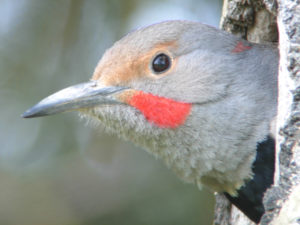
It’s spring! Are you being woken up early by a woodpecker drumming on your chimney or siding? Try not to get mad. It’s just ‘spring fever’ or as the song says, “Love is in the air”. Your bird is a Northern Flicker and he’s not trying to get food, he’s signaling that he’s, um, feeling his oats. Think of it as the avian equivalent of a 17 year-old boy playing the car stereo at top volume. It’s all about the mating game.
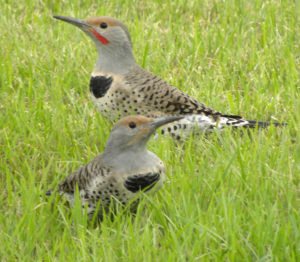
Flickers are our most abundant woodpeckers, distinctive and seen often in many different habitats. They are 12 ½”/nearly 32 cm with bright flight feathers and a white rump, instantly recognizable when they fly. In the west our birds have bright orange-rust underwings whereas eastern birds have yellow. Our males have a red malar (mustache) while eastern males have a black one and a small red crescent on the back of their heads. Both have brown barring on the wings and back, a black-spotted belly and a prominent black
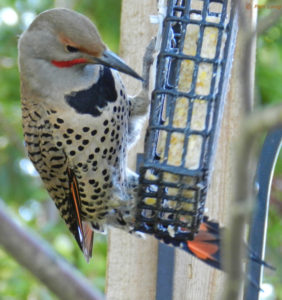
crescent across the breast. Often the two types interbreed resulting in a mix of colours and marks.
Northern Flickers are here year round. They are often seen on the ground where they feed on crawling insects. They love ants! In winter they can be attracted to your garden by suet blocks and I even had one that figured out how to brace itself for a while on a perch feeder to snack on black oil sunflower seeds.
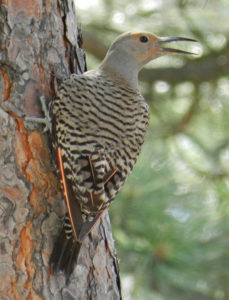
When the sap rises in early spring sapsuckers return from wintering in Mexico and California. (Strictly speaking sapsuckers are not true woodpeckers but they are related.)
Our valley species is the Red-naped Sapsucker. Smaller than flickers at 8 ½”/~22 cm, both sexes have extensive red patches on the top of their heads, at the back of the neck and under the beak. A prominent white stripe down each wing and a touch of yellow in the black and white feathers helps to identify this bird.
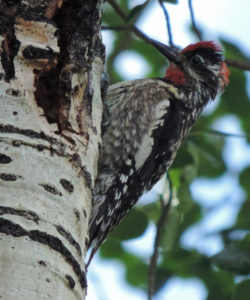
Red-naped Sapsuckers nest in live cottonwoods, birch or aspen trees. You can often see them just above the upper cattle grid on Beaver Lake Road where the conifer forest includes many aspens. Far less obvious than flickers, sapsuckers are fairly quiet and inconspicuous.
All the sapsuckers get their name from their feeding technique which involves chipping out small indentations in a tree’s bark where flowing sap can collect. These are called sap wells and the birds patrol, guard and maintain their sap wells diligently. They eat the sap but also the insects attracted to it, which provide protein for them and their young. (Hummingbirds are frequent visitors to sap wells too.)
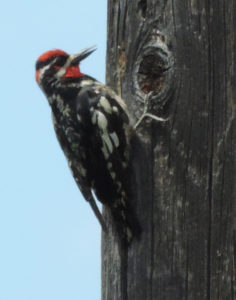
Sapsuckers choose their sap well trees very carefully, seeking a gently sloping branch where the sap will readily collect, some leaf cover for safety and concealment, and close proximity to their nest site. Sapsucker tongues are shorter than those of most woodpeckers but they have fine, brushlike hairs on the tips which help capture sap by capillary action.
So enjoy the birds of spring, even if some of them do wake you up too early!
Pam Laing, Okanagan birder







Sandi H
Thank you for your wonderful blog. I now know the difference between sapsuckers and wood peckers.
Pam
I’m glad to have helped. They are both interesting birds and easy to see.
Pam